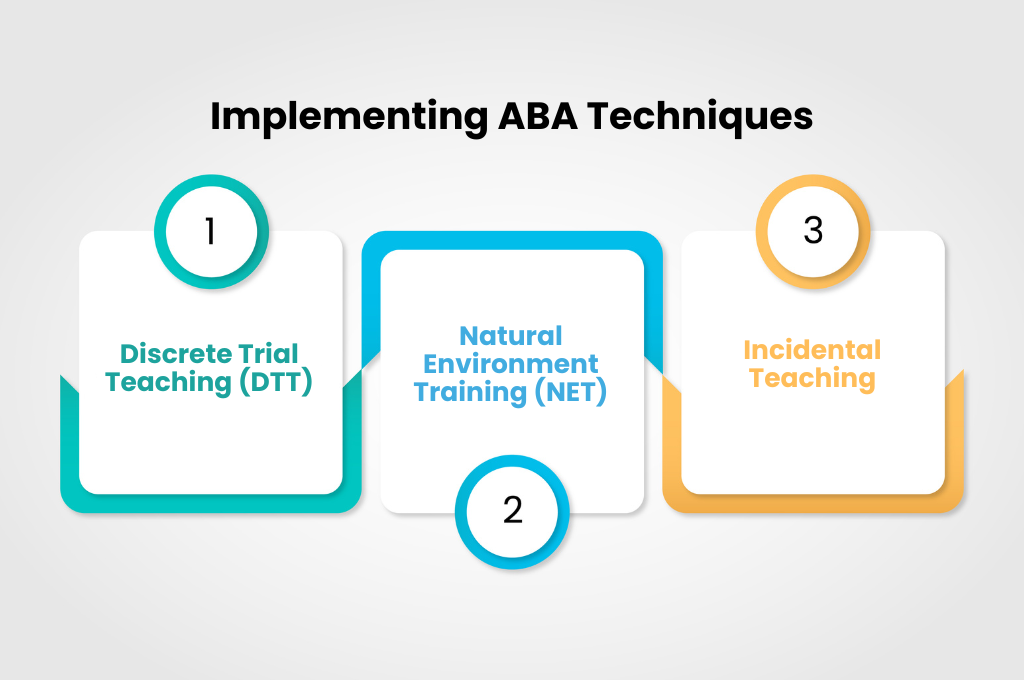Mastering Home-Based ABA Programs: Your Essential Guide
ABA TherapyJuly 17, 2025

Understanding ABA Therapy
Jumping into the world of Applied Behavior Analysis (ABA) Therapy can make a big difference for people with autism spectrum disorder. Learning about the key ideas of ABA therapy and why home-based ABA programs matter is a must for helping folks grow and develop.
What is ABA Therapy?
ABA Therapy is all about a structured method that’s backed by research, aimed at tweaking behaviors for better life outcomes for individuals with autism. Imagine taking a big task and slicing it into bite-sized bits—a lot easier, right? ABA does just that and adds in some positive reinforcement to boost good behaviors. By checking out behavior trends and crafting custom plans, ABA pros work on improving social skills, communication, learning abilities, and independence.
Importance of Home-Based ABA Programs
Home-based ABA programs are like the secret sauce in helping those with autism thrive. Why? Because they happen right at home, where everything is comfy and familiar. It's the perfect spot to practice new skills and put them to use in everyday situations. When caregivers and family members get in on the act, they can work alongside therapists to keep the positive vibes going even when the official sessions stop.
One standout perk of home-based ABA is how personalized it can get. Smart therapists match interventions to fit what the person needs and likes, creating a nurturing space to learn. Plus, folding ABA strategies into daily routines keeps the learning drumbeat going all day.
Teamwork with the pros is pivotal when rolling out a home-based ABA program. A well-thought-out plan with clear goals, structured routines, and consistent behavior strategies means those with autism can make real strides across different areas of their lives.
To dive deeper into spicing up ABA therapy using cool new techniques, check out our article on using video modeling to enhance social skills in autism and find fresh ways to support individuals on the autism spectrum.
Building a Home-Based ABA Program
Creating a home-based ABA (Applied Behavior Analysis) program might seem like assembling a giant jigsaw puzzle, but it's super rewarding for folks with autism. Here, we hash out the nuts and bolts of goal setting, making your space work for you, and using behavior techniques that'll fit right into your daily groove.
Setting Goals and Objectives
Kicking things off on a good note means setting some clear targets. Think of goals as a GPS for progress—without them, you might end up wandering like a lost tourist. Keep these goals specific, realistic, and with a time frame (yep, that SMART stuff your high school counselor rambled on about). That way, everyone—your child, the team, and you—knows how you’re doing and what needs tweaking.
Being a data detective is a must. Track how the little one is responding and behaving to fine-tune things. It's like having a detective’s notebook for behavior clues. Peep at our piece on using video modeling to enhance social skills in autism to get some data-collection tricks up your sleeve.
Creating a Structured Environment
Picture transforming your home into a place where predictability reigns. Kids with autism often do better when things aren't flipping on a whim. So, set up zones for different activities and use visual calendars to keep the daily game plan out in the open. It's like turning your home into a cozy, organized hive of learning.
Pay attention to the sensory vibe, too. Noise, light, and textures can make or break comfort—like Goldilocks and her porridge. Tweak the senses to make a spot that feels just right. More on making sensory spaces cool over at the impact of music therapy on children with autism: an ABA perspective.
Implementing Behavior Strategies
Behavior strategies aren’t about waving a magic wand, but they sure work wonders. Think reinforcement (cheers for good stuff), prompting, and all that jazz. These are like the tools in your toolbox to encourage good behavior.
Shape those strategies like clay—mold them to what sparks joy and connection for the individual. Tailor them with a sprinkle of patience and collaboration with the pros: behavior analysts and therapists. Can’t hurt to have a little help from the ABA wizards! Check out how to tag team with schools at how to effectively collaborate with schools for ABA support.
Building an ABA program at home isn't just a plan; it's a heartfelt mission. It's about creating a nurturing atmosphere, setting achievable goals, and leveraging positive behavior strategies. Consistency, a dash of patience, and joining forces with experts can help turn home into a growth hub for those on the autism spectrum.
Implementing ABA Techniques

To get the hang of Applied Behavior Analysis (ABA) techniques in a home setup, you need to get familiar with methods that fit just right for the individual. Three top-notch ABA strategies often used at home are Discrete Trial Teaching (DTT), Natural Environment Training (NET), and Incidental Teaching.
Discrete Trial Teaching (DTT)
Discrete Trial Teaching (DTT) breaks skills into tiny, chewable pieces taught step by step. With DTT, kids can learn new tricks or tweak behaviors with measurable goals. You give a clear cue, watch how the person responds, and then reinforce it based on that response.
Component of DTT
Description
Antecedent
A clear instruction or cue
Behavior
How the individual responds
Consequence
Reinforcement or feedback based on response
In a home ABA program, DTT homes in on teaching sessions for skills like chatting, making friends, or self-care. The structured setup of DTT helps kids on the autism spectrum pick up skills through regular practice and positive feedback, driving progress in various life skills.
Natural Environment Training (NET)
Natural Environment Training (NET) is all about learning in casual, real-world situations. You teach skills during everyday moments and activities, rather than drills, so the lessons stick and can be applied in different settings later on.
Benefits of NET
- Makes skills transferable
- Boosts flexibility and spontaneity
- Encourages social interaction and involvement
Using NET at home means you slide learning experiences into daily routines and activities. By embedding skill-building in regular settings, NET helps kids carry those skills into new environments, supporting independence and social bonding.
Incidental Teaching
Incidental Teaching seizes learning chances as they occur naturally. During these moments, caregivers or therapists jump in, using interests and the child’s own cues to teach without halting the fun.
Key Elements of Incidental Teaching
- Kid-led initiations
- Nudge and shape responses
- Reward natural behaviors
In home-based ABA, incidental teaching rides on the child's interests and likes. By nurturing a space where learning moments just happen, this technique sparks engagement and participation, fostering new skills and social connections.
Mixing DTT, NET, and incidental teaching in a home ABA program offers holistic support to folks with autism. These tried-and-true practices give structured direction, authentic learning moments, and personalized strategies to boost skill development and improve life's enjoyment.
Monitoring Progress and Adjusting
Keeping a home-based ABA program on track is like trying to make the perfect cup of coffee: you need to keep an eye on it, tweak the ingredients, and take a sip now and then to make sure it’s just right.
Data Collection and Analysis
At the heart of any good ABA brew is data—lots of it. Think of data as your scorecard that tells you how well things are going. By tracking what works, what doesn't, and how the individual's behaviors evolve, you're gathering the intel needed to steer things in the right direction.
Setting up a data collection system is much like setting a morning routine—you want to pinpoint what to focus on and how to measure it. Maybe you’re using behavior charts or ABC records (which stands for Antecedent, Behavior, Consequence—not the alphabet song!), or perhaps you’re jotting down observations as they happen. Reviewing this info regularly helps ABA folks figure out if they’re on the right track or need a course correction.
Collaboration with Professionals
Teaming up with others is like having a group of superheroes on your side. Whether it's ABA experts, caregivers, educators, or therapists, combining their insights means you’re gearing up with a collective brainpower boost. Sharing info and strategies ensures everyone’s rowing in the same direction and that the individual gets the best support across the board.
This collab might mean regular team powwows, progress reports, or brainstorming sessions. Different folks bring different strengths to the table, and that makes the overall approach much richer. Keeping the conversation flowing makes for a united front in supporting the individual’s journey.
Making Necessary Modifications
Imagine driving a car without a steering wheel—you wouldn’t get far, right? In ABA therapy, being flexible with your game plan is just as crucial. Monitoring progress and being ready to tweak the strategy as needed ensures the program stays sharp and on point.
Adjustments might mean shifting how often you do certain activities, updating strategies, or setting new goals as progress is made. Regular chats among team members and feedback loops with the individual and caregivers keep the program adaptable. By listening to what the data and the individual are telling you, you're making sure the whole process is like a well-oiled machine.
Keeping a close watch, collaborating effectively, and being open to changes means your home-based ABA program is primed to hit all the right notes for someone with autism. This ongoing loop of checking and tweaking makes for an approach that's not just effective but keeps the individual moving forward in a meaningful way.
